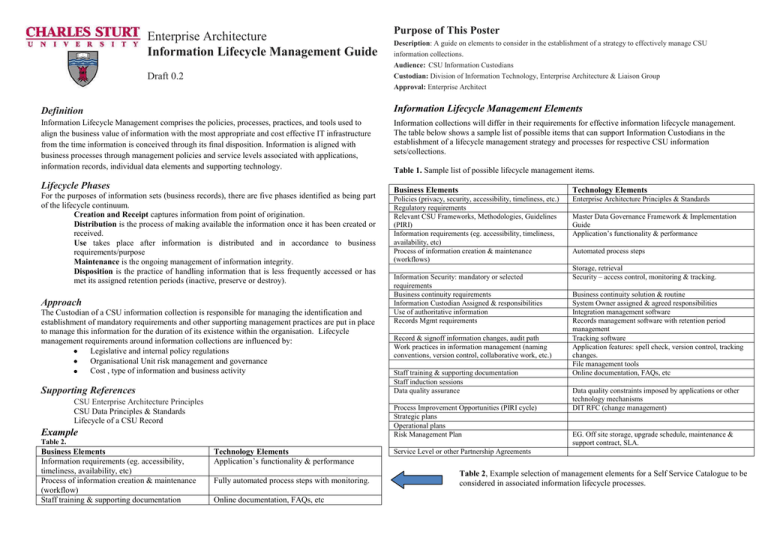Enterprise Architecture Information Lifecycle Management Guide
advertisement

Enterprise Architecture Information Lifecycle Management Guide Draft 0.2 Purpose of This Poster Description: A guide on elements to consider in the establishment of a strategy to effectively manage CSU information collections. Audience: CSU Information Custodians Custodian: Division of Information Technology, Enterprise Architecture & Liaison Group Approval: Enterprise Architect Definition Information Lifecycle Management Elements Information Lifecycle Management comprises the policies, processes, practices, and tools used to align the business value of information with the most appropriate and cost effective IT infrastructure from the time information is conceived through its final disposition. Information is aligned with business processes through management policies and service levels associated with applications, information records, individual data elements and supporting technology. Information collections will differ in their requirements for effective information lifecycle management. The table below shows a sample list of possible items that can support Information Custodians in the establishment of a lifecycle management strategy and processes for respective CSU information sets/collections. Lifecycle Phases For the purposes of information sets (business records), there are five phases identified as being part of the lifecycle continuum. Creation and Receipt captures information from point of origination. Distribution is the process of making available the information once it has been created or received. Use takes place after information is distributed and in accordance to business requirements/purpose Maintenance is the ongoing management of information integrity. Disposition is the practice of handling information that is less frequently accessed or has met its assigned retention periods (inactive, preserve or destroy). Approach The Custodian of a CSU information collection is responsible for managing the identification and establishment of mandatory requirements and other supporting management practices are put in place to manage this information for the duration of its existence within the organisation. Lifecycle management requirements around information collections are influenced by: Legislative and internal policy regulations Organisational Unit risk management and governance Cost , type of information and business activity Table 1. Sample list of possible lifecycle management items. Business Elements Technology Elements Policies (privacy, security, accessibility, timeliness, etc.) Regulatory requirements Relevant CSU Frameworks, Methodologies, Guidelines (PIRI) Information requirements (eg. accessibility, timeliness, availability, etc) Process of information creation & maintenance (workflows) Enterprise Architecture Principles & Standards Information Security: mandatory or selected requirements Business continuity requirements Information Custodian Assigned & responsibilities Use of authoritative information Records Mgmt requirements Record & signoff information changes, audit path Work practices in information management (naming conventions, version control, collaborative work, etc.) Supporting References Staff training & supporting documentation Staff induction sessions Data quality assurance CSU Enterprise Architecture Principles CSU Data Principles & Standards Lifecycle of a CSU Record ExampleLi Process Improvement Opportunities (PIRI cycle) Strategic plans Operational plans Risk Management Plan Table 2. Business Elements Information requirements (eg. accessibility, timeliness, availability, etc) Process of information creation & maintenance (workflow) Staff training & supporting documentation Technology Elements Application’s functionality & performance Fully automated process steps with monitoring. Online documentation, FAQs, etc Master Data Governance Framework & Implementation Guide Application’s functionality & performance Automated process steps Storage, retrieval Security – access control, monitoring & tracking. Business continuity solution & routine System Owner assigned & agreed responsibilities Integration management software Records management software with retention period management Tracking software Application features: spell check, version control, tracking changes. File management tools Online documentation, FAQs, etc Data quality constraints imposed by applications or other technology mechanisms DIT RFC (change management) EG. Off site storage, upgrade schedule, maintenance & support contract, SLA. Service Level or other Partnership Agreements Table 2, Example selection of management elements for a Self Service Catalogue to be considered in associated information lifecycle processes.
